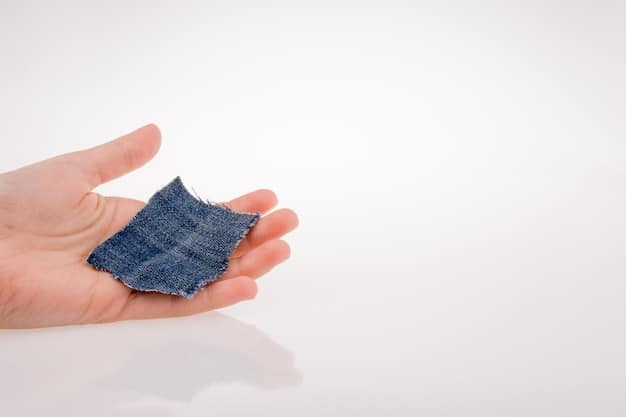The Art of Cuffing: Elevating Unisex Pants & Sleeves

Mastering the art of cuffing offers a transformative approach to unisex fashion, allowing individuals to customize fit, express personal style, and elevate their aesthetic through simple yet impactful adjustments to pants and sleeves.
In the evolving landscape of fashion, where boundaries blur and individual expression takes precedence, the subtle art of cuffing emerges as a powerful tool. The Art of Cuffing: How to Elevate Your Unisex Pants and Sleeves goes beyond mere practicality; it’s a statement, a deliberate act of styling that can transform an ordinary garment into a focal point of personal flair. Whether you’re aiming for a casual rolled-up aesthetic or a meticulously tailored fold, understanding the nuances of this technique can unlock new dimensions in your unisex wardrobe.
The Philosophy of Cuffing: More Than Just a Roll
Cuffing, at its core, is an intentional styling choice that adds depth and character to an outfit. It’s not simply about shortening a hem or pushing up a sleeve; it’s about altering the silhouette, drawing attention to footwear or wrist accessories, and injecting a sense of relaxed sophistication or edgy precision. This practice is particularly potent in unisex fashion, where garments are often designed with a looser, more adaptable fit, providing ample opportunity for personalization.
The philosophy extends to how one perceives clothing. Instead of a fixed form, garments become canvases for individual creativity. A well-executed cuff can convey effortless cool, meticulous attention to detail, or functional pragmatism, all while enhancing the overall aesthetic. It’s a testament to the idea that true style often lies in the details, in the deliberate choices that shape how fabric drapes and interacts with the body.
Beyond the Hem: Understanding Cuffing’s Impact
- Dimension and Proportion: Cuffing can dramatically alter the perception of leg length or arm length, creating new proportional balances.
- Highlighting Accessories: A perfectly cuffed pant leg draws eyes to your sneakers or boots, while a rolled sleeve showcases watches or bracelets.
- Textural Contrast: The inside of a pant leg or sleeve often reveals a different texture or color, adding visual interest when cuffed.
- Personalized Fit: For unisex items, cuffing allows wearers to fine-tune the fit, moving away from generic sizing towards a more bespoke feel.
The act of cuffing introduces an element of dynamism to static clothing. It suggests movement, an active engagement with one’s attire, rather than a passive acceptance of its factory-set form. This active modification transforms clothing from something worn into something styled, bridging the gap between utilitarian function and expressive art. It also embraces the fluid nature of unisex fashion, where adaptability and versatility are key.
Historical Roots and Modern Interpretations
While cuffing might seem like a contemporary trend, its roots are deep, often stemming from practical needs like keeping hems clean or sleeves out of the way. From turn-of-the-century workwear to the rebellious rolls of 1950s youth, the cuffed garment has continually resurfaced, adapting its meaning with each era. Today, it encapsulates a blend of utility and deliberate fashion, appealing to diverse aesthetics.
- Workwear Legacy: Early work pants were often cuffed to prevent fraying and keep dirt off, a practicality that evolved into a style statement.
- Rebellious Edge: In mid-20th century subcultures, cuffed jeans signaled a casual, non-conformist attitude.
- High Fashion Adoption: Designers now incorporate cuffed elements, bringing this street-style staple to haute couture runways.
The enduring appeal of cuffing lies in its simplicity and versatility. It requires no sewing, no elaborate alterations, just a knack for folding and an eye for proportion. This accessibility makes it a powerful tool for anyone looking to refine their personal style, regardless of their budget or fashion expertise. It’s about making the most of what you have, transforming the ordinary into something unique and intentional.
In essence, the philosophy of cuffing is one of empowered styling. It’s about taking control of your garments, making them work for you, and expressing a subtle yet impactful aspect of your individuality. It transforms clothing from a mere covering into a canvas for creative self-expression, elevating unisex pieces into personal statements.
Mastering the Cuff: Techniques for Pants
The way you cuff your pants can drastically change the look and feel of your entire outfit. From subtle turns to bold rolls, each technique serves a different purpose and complements specific styles of unisex trousers. Understanding these methods is key to unlocking the full potential of your wardrobe and ensuring your look is polished and intentional.
Choosing the right cuff depends on several factors: the fabric of your pants, the desired level of formality, your footwear, and the overall aesthetic you’re aiming for. A heavy denim will hold a crisp roll differently than a light linen, and a wide-leg pant will naturally favor a different cuff than a tapered jogger. It’s an intuitive process that becomes easier with practice.
The Classic Single Roll
The single roll is perhaps the most common and easiest cuffing technique. Ideal for a relaxed, casual look, it involves a simple fold upwards, usually about an inch or two in width. This works particularly well with jeans, chinos, and other casual trousers, providing a neat finish without being too structured. It’s perfect for showcasing stylish sneakers or low-cut boots.
To execute, simply take the hem of your pants and fold it upwards once. Ensure the fold is even all around. The width of this fold can vary, but a consistent width creates a cleaner appearance. This cuff is versatile and can be adapted for a wide range of unisex styles, from street casual to smart-casual daily wear. It maintains a clean line, preventing the pant from looking bulky.
It’s important to consider the length of your pants before applying a single roll. If your pants are already quite short, a single roll might make them oddly cropped. Conversely, if they’re too long, a single roll might not be enough to achieve the desired shortening, potentially requiring a second, tighter roll instead.
The Double Roll (or Pinroll)
For a slightly more refined and tapered look, especially with denim or thicker fabrics, the double roll is an excellent choice. This technique involves an initial, narrow fold, followed by a second, equally narrow fold directly over the first. The result is a substantial, clean cuff that can help slim down the ankle area of a wider pant.
Often referred to as a “pinroll” when executed very tightly to taper the leg, this method is perfect for accentuating high-top sneakers, boots, or making a bold statement with your socks. It’s particularly effective for unisex jeans or cargo pants where you want a cleaner break at the ankle.
- The Pinroll: For a tight pinroll, pinch the inseam of your pants near the ankle to remove excess fabric, then fold it over onto itself to create a narrow, tapering fold. Once pinched, make one small roll, then another directly on top of the first. This creates a very neat, tailored fit around the ankle.
- Benefits: Reduces bulk around the ankles, ideal for showing off footwear, creates a modern, clean silhouette often seen in contemporary unisex street style.
The key to a good double roll or pinroll is precision. The folds must be even and relatively tight to prevent them from unraveling throughout the day. This attention to detail elevates the cuff from a simple adjustment to a deliberate styling choice, communicating a keen sense of fashion awareness.
The Sloppy Roll (or Messy Cuff)
Contrasting with the precision of the double roll, the sloppy roll embraces a more undone, effortless aesthetic. This technique involves less precise, often uneven folds, giving the appearance that the pants were carelessly (but stylishly) rolled up. It’s perfect for a relaxed, bohemian, or urban-casual vibe.
Commonly seen with oversized or wide-leg unisex pants, this cuff method adds character and a lived-in feel. It works best with softer fabrics that can slouch naturally, like linen, softer denim, or lightweight canvas. The goal is not perfection, but an organic, unfussy appeal that suggests confidence in an unconventional style.
- Execution: Simply roll your pants up a few times, varying the width of each roll slightly. Don’t worry about perfection; aim for a relaxed, slightly rumpled look.
- Best For: Casual outings, outdoor activities, or when paired with loose-fitting tops and comfortable footwear for an effortlessly cool appearance.
While seemingly effortless, a good messy cuff still requires a certain eye for balance to ensure it complements the rest of your outfit. It’s about intentional disarray, creating a look that is both comfortable and stylish without appearing overly contrived. This style perfectly embodies the relaxed ethos often found in unisex fashion.

Elevating Sleeves: Techniques for Unisex Tops
Just as cuffing pants can transform an outfit, rolling up sleeves offers a simple yet impactful way to refine the look of unisex shirts, jackets, and sweaters. It’s a versatile styling technique that can adapt a garment for different temperatures, occasions, and personal aesthetic preferences, bringing a subtle dynamism to your upper half.
When approaching sleeve cuffing, consider the garment’s material, its intended drape, and the desired effect. A crisp, formal shirt will demand a different technique than a relaxed denim jacket or a cozy knit sweater. The aim is always to enhance the overall silhouette and add a thoughtful touch to your ensemble.
The Classic Roll
The classic roll is the most straightforward and universally applicable method for sleeves. It involves folding the cuff of the shirt or jacket up once or twice, creating a clean, defined edge. This technique is suitable for almost any long-sleeved top and provides a neat, pulled-together appearance.
For a standard shirt, simply unbutton the cuff and fold it upwards to the desired length. For a more casual look, you might push the sleeve up slightly without full folds, letting it gather naturally. This method works well for office environments where you need to maintain a level of professionalism while still allowing for movement.
- Casual Elegance: A classic roll on a button-down shirt paired with cuffed unisex chinos creates a smart-casual ensemble, perfect for weekend brunches or creative workspaces.
- Functional Comfort: Rolling up sleeves is also practical for tasks requiring unhindered arm movement, seamlessly blending utility with style.
The classic roll is a go-to for adding a touch of laid-back sophistication. It communicates a sense of being “at ease” without appearing sloppy, making it ideal for unisex garments that prioritize comfort and versatility. It’s a subtle adjustment that speaks volumes about attention to detail.
The Master Roll (or J. Crew Roll)
For a more polished and enduring sleeve roll, the master roll, sometimes called the J. Crew roll, is highly recommended. This technique keeps the cuff securely in place and adds a sophisticated, tailored look. It works exceptionally well with stiffer fabrics like Oxford cotton shirts and denim jackets, providing structure and clean lines.
To perform the master roll: First, unbutton the cuff and fold the entire cuff upwards until it reaches just below the elbow. Then, take the bottom edge of this folded section and fold it upwards again, but only halfway, leaving a portion of the original cuff exposed. This creates a neat, layered effect that is surprisingly durable.
- Clean Finish: The master roll creates a compact, secure cuff that is unlikely to unravel, maintaining a polished appearance throughout the day.
- Distinctive Look: The exposed inner lining of the cuff adds a subtle point of interest, showcasing contrast stitching or fabric details.
The master roll is a preferred choice for those seeking a more formal or structured approach to sleeve cuffing. It suggests a keen eye for detail and a desire for a refined aesthetic. It lends itself well to unisex blazers and shirts, adding a stylish edge to otherwise straightforward garments.
The Casual Scrunch
Conversely, the casual scrunch embraces a relaxed, effortless vibe. This technique involves simply pushing or scrunching sleeves up the arm without precise folds, allowing the fabric to gather naturally. It creates a comfortable, lived-in look, perfect for laid-back unisex hoodies, sweaters, or casual long-sleeve tees.
This method is ideal for softer, more pliable fabrics that drape well and don’t hold a crisp fold. It imparts an air of insouciance, suggesting a spontaneous and unpretentious approach to style. The casual scrunch is all about comfort and freedom of movement, reflecting a relaxed approach to daily wear.
- Effortless Style: Perfect for achieving an “I just threw this on” look that still retains a sense of style and comfort.
- Warm-Weather Friendly: Instantly adapts long-sleeved items for warmer weather without making them feel too formal or stiff.
While seemingly simple, the casual scrunch still requires a sense of balance. The sleeve should appear rumpled, not messy or unkempt. It should look like an intentional act of relaxation, rather than an afterthought. This informal approach to sleeve styling contributes greatly to the appeal of many unisex casual outfits.
Fabric Matters: Tailoring Cuffs to Materials
The type of fabric plays a crucial role in how a cuff will behave and look. Different materials drape, wrinkle, and hold folds in distinct ways, necessitating a tailored approach to cuffing. What works beautifully for a rigid denim might look sloppy on a delicate silk, and vice versa. Understanding these nuances is essential for achieving a perfected cuff every time.
Ignoring the fabric’s properties can lead to disappointment, with cuffs that unravel, look bulky, or simply don’t sit right. Conversely, a mindful approach to material allows you to leverage its inherent characteristics to your advantage, enhancing the garment’s overall aesthetic and ensuring comfort.
Heavy Fabrics: Denim and Canvas
Heavy fabrics like denim, canvas, and thick twill naturally hold their shape well, making them ideal for structured cuffs. These materials benefit from techniques that create crisp, defined lines.
- Best Cuffing Techniques: The double roll, pinroll, and master roll are excellent choices. Their inherent stiffness ensures the folds remain in place throughout the day.
- Benefits: Creates a strong, architectural look; highlights the robust texture of the fabric; adds a utilitarian or workwear aesthetic.
When cuffing heavy denim or canvas pants, the substantial nature of the fabric means that even a single wide roll can create a significant visual break. This can be used to emphasize chunky footwear or draw attention to the lower leg. For sleeves on denim jackets or heavy shirts, the master roll provides a clean, sturdy finish that complements the fabric’s durability.
Lightweight Fabrics: Linen, Chinos, and Rayon
Lightweight fabrics like linen, thin cotton chinos, and rayon have a softer drape and are more prone to wrinkling. Cuffing them requires a gentler touch and an appreciation for their natural fluidity.
- Best Cuffing Techniques: The casual single roll, sloppy roll, or a gentle scrunch for sleeves. Overly structured folds can look stiff and unnatural on these materials.
- Benefits: Enhances the airy, relaxed feel of the fabric; allows for natural movement and flow; perfect for warm-weather unisex outfits.
With linen pants, a loose, slightly rumpled single roll or a casual scrunch is often preferred, embracing the fabric’s inherent crinkles and relaxed vibe. For linen shirts, a simple push-up or a soft, uneven roll works best, conveying an effortless, comfortable style that aligns with the fabric’s breathability and casual appeal. The goal is flow, not rigid structure.
Mid-Weight Fabrics: Cotton, Flannel, and Poplin
Mid-weight fabrics offer a good balance between structure and drape, making them versatile for various cuffing techniques. These include classic cottons, flannels (for shirts), and poplin.
- Best Cuffing Techniques: Most cuffing methods can be successfully applied. The classic single roll, double roll, and classic sleeve roll are all appropriate.
- Consideration: The specific weave and finish of the fabric will influence the best outcome. A crisp poplin dress shirt, for example, will benefit from a more precise roll than a soft flannel shirt.
For cotton unisex trousers, a clean single or double roll can provide a smart-casual look. Cotton blend shirts lend themselves well to both classic and master rolls, depending on the desired level of formality. The adaptability of these fabrics means you have more freedom to experiment and find the cuff that best suits your overall style and the occasion.
Ultimately, fabric is the foundational element that dictates the success of your cuffing endeavors. By understanding how different materials react to folding and manipulation, you can make informed choices that elevate your unisex garments from merely worn to truly styled. Pay attention to the way the fabric feels and behaves; it will tell you the best way to cuff it.
Styling Synergy: Pairing Cuffs with Footwear and Accessories
The art of cuffing doesn’t exist in a vacuum; it’s an integral part of a larger styling ecosystem. The way you cuff your pants and sleeves should work in harmony with your footwear and accessories, creating a cohesive and purposeful ensemble. This synergy is key to elevating a unisex outfit from simply acceptable to truly noteworthy.
Consider your cuffs as frames for your footwear and wristwear. A well-chosen cuff can highlight a unique sneaker design, draw attention to a statement sock, or place emphasis on a watch or bracelet. Conversely, a poorly matched cuff can unintentionally detract from these elements, creating visual clutter or imbalance.
Pants and Footwear: A Perfect Match
The relationship between your cuffed pants and your shoes is arguably the most critical aspect of cuffing. The break of your pant leg – where the fabric meets the shoe – is significantly altered by a cuff, and this interaction influences the entire silhouette.
- Sneakers: For casual sneakers, a classic single roll or a tight pinroll works wonders. This allows the sneaker to be fully visible, showcasing its design. It creates a sporty, modern aesthetic that is popular in unisex street styles.
- Boots: When wearing boots, particularly taller ones, a wider single roll or a substantial double roll is often preferred. This allows the boot’s shaft to sit comfortably without bunching the pant fabric, creating a clean line.
- Loafers/Dress Shoes: For more formal or smart-casual footwear, a very subtle, narrow single cuff or even no cuff at all (a slight break) might be more appropriate. The goal is a refined look that doesn’t distract from the polished shoe.
The width and height of your cuff should be in proportion to your footwear. A thick, bulky cuff with delicate dress shoes can look awkward, just as a minimal cuff might get lost over chunky boots. Experiment to find the balance that feels right for your personal style and the specific items you’re pairing.
Socks also play a significant role here. A well-chosen, colorful, or patterned sock can become a focal point when peeking out from a cuffed pant leg, adding a playful or sophisticated touch. Conversely, an invisible or neutral sock maintains a cleaner, more minimalist appearance.
Sleeves and Wristwear: Drawing the Eye
Similar to pants and footwear, cuffed sleeves create an opportunity to highlight wrist accessories. Watches, bracelets, and even rings can be showcased more effectively with the right sleeve roll.
- Watches: A master roll or a neat classic roll pulls the fabric away from the wrist, allowing a watch to stand out as a central accessory. This is particularly effective for larger, bolder watch designs.
- Bracelets: For stacks of bracelets or delicate wristwear, a casual scrunch or pushed-up sleeve creates a relaxed backdrop, letting the accessories shine without being constrained.
- Rings: While not directly related to sleeve cuffing, a well-rolled sleeve can indirectly draw attention to the hands, making rings more noticeable.
The depth and looseness of your sleeve cuff should consider the size and style of your wristwear. You want the accessories to feel like a natural extension of your outfit, not an afterthought. For unisex layered looks with long-sleeved undershirts, a strategic cuff can reveal a sleeve from the inner layer, adding another dimension of visual interest.
Ultimately, styling synergy is about creating a harmonious visual narrative. Every element of your outfit, from the way your pants break at your ankles to the exposure of your wrist, contributes to the overall impression. By thoughtfully pairing your cuffing techniques with your footwear and accessories, you elevate your style, demonstrating an acute awareness of detail and proportion.
Beyond Trends: Timeless Cuffing for Unisex Wardrobes
While fashion trends come and go, the core principles of effective cuffing remain timeless. For a unisex wardrobe, which often prioritizes versatility and longevity, understanding how to apply cuffing techniques that transcend fleeting fads is invaluable. It’s about cultivating skills that allow you to adapt garments to various contexts, ensuring your style remains current without being dictated by passing whims.
A timeless approach to cuffing focuses on functionality, proportion, and subtle expression. It’s not about following a specific cuff width or roll style that’s “in” for the season, but about mastering the ability to manipulate fabric to achieve a desired fit, comfort level, and aesthetic impact that endures.
Functionality Meets Form
Many classic cuffing techniques originated from practical needs – keeping trouser hems out of puddles, protecting shirt cuffs from wear, or simply pushing sleeves up to get work done. Integrating this functional versatility into your styling ensures that your cuffs are not just decorative but also serve a purpose, making your unisex garments more adaptable.
- Seasonal Adaptability: Rolling up sleeves or pant legs is a natural way to transition pieces between seasons, making long-sleeved shirts or full-length trousers suitable for warmer weather.
- Activity-Based Styling: A quick cuff can prepare an outfit for hands-on tasks, whether it’s cooking, writing, or exploring outdoors, embodying the ease of unisex design.
This functional aspect is particularly important in unisex fashion, where garments are often designed with a sense of practicality and ease of wear. Timeless cuffing embraces this by allowing clothing to perform multiple roles, seamlessly shifting from casual comfort to a more refined look with a simple adjustment.
Proportional Harmony
Regardless of current trends, good proportion is always in style. Cuffing allows you to fine-tune the proportions of your unisex garments relative to your body and your footwear, creating a balanced and aesthetically pleasing silhouette. This understanding of proportion is what makes a cuffed look appear intentional and well-thought-out.
Consider the interplay between the width of your pant leg, the height of your cuff, and the style of your shoes. A wide cuff on a skinny pant can emphasize the narrowness of the leg, while a shorter cuff on a wider pant can balance out length. It’s about achieving visual equilibrium that flatters the wearer.
- Ankle Definition: A well-executed cuff can create a clean line at the ankle, providing definition and drawing attention to footwear without shortening the leg disproportionately.
- Arm Length Adjustment: For unisex sleeves, cuffing ensures that arm length feels appropriate, preventing sleeves from looking too long or cumbersome, particularly when layering.
Timeless cuffing is about finding the sweet spot where the cuff enhances the garment’s fit and the wearer’s proportions, rather than merely adding a decorative element. It’s subtle yet impactful, a quiet statement of thoughtful styling that never goes out of fashion.
Subtle Expression and Personal Touch
Finally, timeless cuffing allows for subtle personal expression without relying on overtly trendy statements. It’s a quiet way to show attention to detail and an understanding of garment manipulation. In a unisex wardrobe, where individual flair is celebrated, these small adjustments speak volumes.
The choice of a precise master roll over a casual scrunch, or a wide single roll versus a tight pinroll, communicates nuanced aspects of your personal style. It’s a way to personalize off-the-rack garments and make them uniquely yours, reflecting your aesthetic preferences without resorting to overt branding or overly complex styling.
By focusing on functionality, proportional harmony, and subtle expression, you equip yourself with the skills to incorporate cuffing into your unisex wardrobe in a way that remains elegant and relevant, year after year. It’s an investment in skill that pays dividends in enduring style.

Common Cuffing Mistakes to Avoid
While cuffing might seem like a simple technique, there are common pitfalls that can undermine your efforts and detract from your overall look. Being aware of these mistakes can help you refine your approach and ensure your cuffed garments always look polished and intentional. The difference between a stylish cuff and a sloppy one often lies in these subtle details.
The goal is to enhance your unisex outfit, not to create unnecessary bulk or odd proportions. A great cuff looks deliberate, even if it’s meant to convey a casual vibe. Avoiding these common errors ensures that your styling choices contribute positively to your aesthetic.
Over-Cuffing: Too Many Rolls or Too Much Bulk
One of the most frequent mistakes is using too many rolls or making each roll too wide, resulting in an overly bulky cuff. This can make the hem of your pants or sleeves appear heavy and disproportionate, especially with thicker fabrics.
- Pants: For most unisex pants, two clean rolls are usually sufficient. More than that can create a “stair-step” effect that looks cumbersome. Keep the width of each roll moderate, ideally one to two inches, depending on the pant style.
- Sleeves: Similarly, for sleeves, excessive rolling can create a thick, uncomfortable band around your arm. Aim for a clean classic roll or a master roll, which keeps bulk to a minimum while maintaining structure.
Over-cuffing disrupts the flow of the garment, making the lower half of pants or the forearms of shirts look stunted. It’s about finding that sweet spot where the cuff adds character without overpowering the garment’s natural silhouette. Less is often more when it comes to the number and size of your rolls.
Inconsistent Rolls: Uneven or Sloppy Folds
While the “sloppy roll” for pants can be a deliberate stylish choice, inconsistent rolls that are simply messy rather than artfully casual are a common mistake. This includes uneven widths, folds that unravel easily, or cuffs that are lopsided.
Even for a casual look, there’s an underlying intention. If your cuff is meant to be neat, ensure both pant legs or shirt sleeves are cuffed to the same height and with similar precision. If it’s meant to be relaxed, ensure the “messiness” looks natural and not simply unfinished.
- Precision Matters: For structured cuffs like the pinroll or master roll, taking the time to make neat, even folds is crucial for a polished look.
- Balance is Key: Even in casual styles, ensure a general sense of balance. One cuff shouldn’t be significantly higher or wider than the other unless it’s a deliberate asymmetrical design choice.
Inconsistent cuffing can signal a lack of attention to detail, undermining an otherwise well-composed outfit. It’s worth taking a few extra seconds to ensure your cuffs are consistent with your chosen aesthetic and complement the symmetrical nature of most unisex garments.
Ignoring Fabric and Footwear Compatibility
As discussed earlier, disregarding how the fabric of your garment interacts with a specific cuffing technique, or how the cuff pairs with your footwear, is a major misstep. A beautiful cuff on its own might look awkward if it clashes with the material or your shoes.
For example, attempting a crisp pinroll on a flowy rayon pant will likely result in a crumpled mess that doesn’t hold its shape. Similarly, a wide, chunky cuff on a pair of sleek, minimalist sneakers might create an unbalanced visual. Each element needs to work together harmoniously.
- Fabric First: Always consider the material’s drape and thickness before choosing a cuffing method.
- Footwear Fit: Ensure your cuff length and style complement your shoes. The cuff should frame your footwear, not obscure it or create an awkward gap.
The most successful cuffs are those that integrate seamlessly into the overall outfit, enhancing its elements rather than clashing with them. By avoiding these common mistakes, you ensure that The Art of Cuffing: How to Elevate Your Unisex Pants and Sleeves truly elevates your style, rather than detracting from it.
Maintaining Your Cuffed Look: Tips for Longevity
Once you’ve mastered the art of cuffing and achieved your desired aesthetic, the next challenge is maintaining that perfect roll or fold throughout the day. While some cuffs are designed to be fluid, others require a bit more attention to stay crisp and intentional. Longevity in styling ensures your effort pays off from morning to night.
This often comes down to a combination of technique, fabric choice, and subtle adjustments throughout the day. A well-maintained cuff looks professional and deliberate, reinforcing the overall polished appearance of your unisex outfit. It’s about making your style choices endure beyond the initial dressing.
The Right Fit at the Outset
The foundation of a long-lasting cuff begins with the garment’s initial fit. If your pants are excessively long or your sleeves are dramatically oversized, maintaining a neat cuff will be a constant battle. While cuffing can adapt a fit, it cannot entirely compensate for a wrong size.
- Pants: For a consistent cuff, choose pants that are only slightly longer than your ideal uncuffed length. This provides enough fabric for a neat fold without creating excessive bulk.
- Sleeves: Similarly, shirts or jackets with sleeves that are close to your natural arm length will hold cuffs better than those that are several inches too long.
Starting with a garment that fits reasonably well means the cuff is an enhancement, not a remedial action. This reduces tension on the folded fabric, helping it stay in place longer and resist slipping or bunching.
Securing the Fold: When and How
For certain fabrics and cuff styles, a bit of extra security can go a long way. While not always necessary, especially for casual rolls, some scenarios benefit from a subtle reinforcement.
- Fabric Weight and Stiffness: Stiffer fabrics like heavy denim or starched cotton tend to hold folds well on their own. Softer, lighter fabrics like linen or rayon may require more effort to stay put, or they might be best left to the ‘casual scrunch’ approach where movement is part of the charm.
- Temporary Solutions: For a particularly stubborn cuff that needs to stay pristine for an event, a tiny piece of fashion tape or a hidden safety pin can be used on the inside of the fold. This is a temporary fix for special occasions, not everyday wear.
- Ironing: Pre-creasing your cuff with an iron (especially for tailored looks like the pinroll or master roll) can provide a sharp line and help the fabric retain its shape throughout the day. This is particularly effective for shirts and chinos.
The goal is to achieve a stable cuff without making it look unnaturally stiff or forced. The security methods should be discreet, allowing the cuff to appear effortlessly neat. This ensures that the aesthetic of your unisex clothing remains uncompromised by practical adjustments.
Dealing with Unraveling and Readjustment
Even the most perfectly executed cuff can start to unravel or shift over the course of a busy day, especially with movement. Knowing how to quickly and subtly readjust ensures your look stays sharp.
For pants, a discreet tug on the hem or a quick re-roll in a restroom can easily fix a sagging cuff. For sleeves, a brief push-up or re-fold is typically all that’s needed. The key is to be aware of your cuffs and make small, proactive adjustments rather than letting them completely fall apart.
Embracing a slightly lived-in feel for certain cuff styles, particularly the casual or sloppy rolls, can also mitigate the need for constant maintenance. These styles are designed to look relaxed, so a little natural movement is part of their charm. Understanding when to be precise and when to embrace a relaxed imperfection is part of the true art of cuffing.
By considering the initial fit, employing strategic reinforcement when necessary, and being comfortable with quick readjustments, you can ensure your cuffed unisex garments maintain their intended style and elevate your look throughout any activity.
| Key Point | Brief Description |
|---|---|
| 👖 Cuffing Pants | Techniques like single roll, double roll, or pinroll can alter silhouette and highlight footwear for various styles. |
| 👕 Cuffing Sleeves | Classic, master, or casual scrunch rolls adjust fit, showcase wristwear, and adapt to different occasions. |
| 🧵 Fabric & Footwear Match | Choosing the right cuff depends on material and shoe style; heavy fabrics suit structured rolls, light fabrics suit relaxed ones. |
| 🕰️ Timeless Appeal | Cuffing offers functional, proportional, and expressive versatility, transcending trends for enduring unisex style. |
FAQs: The Art of Cuffing
Cuffing refers to the act of folding up the bottom hem of pants or the sleeves of shirts and jackets. It’s a styling technique used to adjust length, alter silhouette, and add a decorative or intentional element to an outfit. This simple modification can significantly change the overall look and feel of a garment while being practical.
Cuffing is particularly important for unisex clothing because these garments are often designed with a looser or more adaptable fit to suit various body types. Cuffing allows individuals to personalize the fit, refine proportions, and infuse their unique style into pieces that might otherwise be generic, enhancing versatility and self-expression.
Choosing the best cuffing technique depends on the fabric, your footwear, and the desired aesthetic. For heavy fabrics like denim, structured rolls (double roll, pinroll) work well. For lighter fabrics like linen, a casual single roll or sloppy cuff is often better. Consider how the cuff will interact with your shoes, whether sneakers or boots.
While most long-sleeved shirts can be cuffed, the best technique varies. Crisp cotton shirts hold master rolls well, while softer materials like flannel or jersey might suit a casual scrunch or simple push-up. The fabric’s drape and the sleeve’s button cuff (if present) will influence which method looks most natural and holds best, enhancing comfort and style.
Common mistakes include over-cuffing (too much bulk), inconsistent rolls (uneven or sloppy when a neat look is intended), and ignoring fabric or footwear compatibility. Always ensure your cuffs are proportionate to your body and work harmoniously with your outfit’s other elements, contributing to a cohesive and intentional look.
Conclusion
The nuanced practice of cuffing, whether applied to the hem of unisex pants or the sleeves of a favorite shirt, transcends mere trendiness to become a foundational element of informed personal style. It’s a testament to the power of small details, demonstrating how deliberate adjustments can profoundly alter a garment’s fit, proportion, and overall aesthetic. By understanding the techniques, considering fabric and footwear, and avoiding common pitfalls, anyone can master this simple yet impactful art. Ultimately, the ability to thoughtfully cuff transforms clothing from something simply worn into a canvas for individual expression, solidifying its place as an essential skill in cultivating a versatile and timeless unisex wardrobe.





